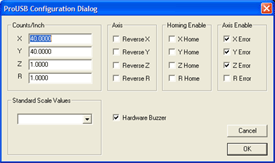Geomet Versions - 6.66.006.001
 Before
the U/V Rotary Axis Table can be used, Geomet needs to know the counts per
degree for each axis which is referred to as the scale factor. To
determine the counts per degree, consult the manufacturer specifications
for the encoder model or from the supplied CMM information packet. This
information i normally the counts per revolution. Divide this number by
360.0 to get the counts per degree.
Before
the U/V Rotary Axis Table can be used, Geomet needs to know the counts per
degree for each axis which is referred to as the scale factor. To
determine the counts per degree, consult the manufacturer specifications
for the encoder model or from the supplied CMM information packet. This
information i normally the counts per revolution. Divide this number by
360.0 to get the counts per degree.
Geomet utilizes the ProCounter II CMM Interface card that incorporates a
quadrature digital counter to processes the counting of the encoder signals.
This is done to increase the accuracy during rotation.
To determine the counts per degree that will be entered in
the setup control, multiply the encoder counts as stated in the manufacturer
specifications by 4.0 followed a division of 360.0, see example below
Mfg. Encoder Counts * 4.0 / 360.0 = Scale Factor
3600 * 4.0 / 360.0 = 40.0
To open the U/V Encoder Scale Factor tool, use the drop-down menu:
[System→Interface
Configuration]
Enter the counts per revolution in the setup control for
the X-Axis and Y-Axis. The Z-Axis and R-Axis should be set to 1.0 and press
<Ok> when
finished. In this example, the encoder specification for counts per
revolution was 3,600. Multiply that value by 4 to obtain the 14,400 counts
per revolution, then divide by 360.0 to obtain the 40.0 counts per degree which is then entered into the setup control, see example
above.
In some cases the actual encoder counts per revolution may need to be
adjusted to compensate for any deviation of the encoder. This is normally
done by a calibration service after they have determined the actual counts
per revolution.





